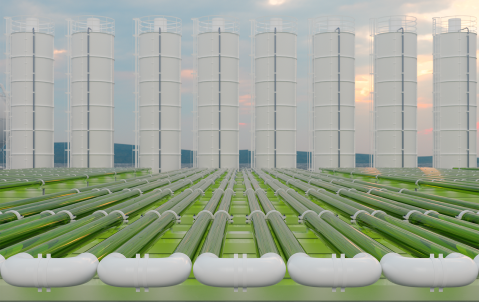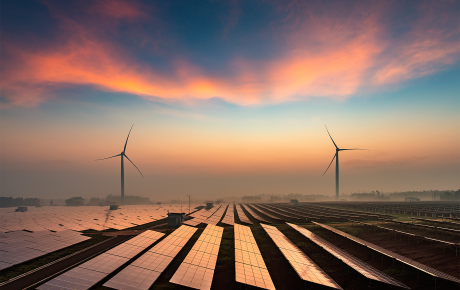
How storing CO² could help tackle climate change
Carbon capture and storage (CCS) – which involves extracting the harmful pollutants out of air and storing it deep underground – is seen as being an essential tool in tackling climate change and enabling the global economy to move to net-zero emissions by the middle of this century.
“The sooner we include carbon capture, use and storage technologies…the more likely we will be to achieve Paris Agreement climate targets,” wrote King Charles III in 2021.
The oil and gas industry can play an important part in rapidly developing CCS technology. “Existing expertise and technology within the oil and gas sector has the ability to accelerate the rate of CO² reduction within our atmosphere,” says James Daykin, Marine & Energy Liability Senior Underwriter at Hiscox London Market.
The oil and gas industry can play an important part in rapidly developing CCS technology. “Existing expertise and technology within the oil and gas sector has the ability to accelerate the rate of CO² reduction within our atmosphere,” says James Daykin, Marine & Energy Liability Senior Underwriter at Hiscox London Market.
How does carbon capture work?
The CO² is chemically extracted from the exhaust fumes produced by heavy industry, thereby cutting greenhouse gas emissions; it is then liquified and stored, ready to be shipped to a safe storage area.
Achieving net zero will be impossible without carbon capture, says the International Energy Agency (IEA), as it is seen as virtually the only way to cut emissions from ‘hard-to-abate’ heavy industries, which produce emissions that can’t be avoided, such as cement, steel, and chemical production, as well as conventional power generation.
The same technology could also be used to cut the amount of carbon already in the atmosphere, by extracting CO² from the air using massive filtration plants. Occidental plans to build the world’s largest direct-air-capture plant in Texas, which could take as much as 1 million tonnes of CO² each year from the surrounding air.
What will be done with the captured CO²?
Some of it can be used to help make other products – it’s used already in the oil and gas industry, food manufacture, fertilizer production, and there’s work being done to use it to make a new generation of cement, plastics, and biofuels, as well as other materials. But much of the captured CO² will have to be stored.
Scientists believe there is more than enough storage capacity around the world to take the amount of CO² needed to be captured to meet net-zero emissions targets. Former oil and gas reservoirs are ideal storage facilities; the CO² is pumped into a vast underground chamber of porous rock, from which it can’t escape because it is under an impermeable layer of ‘cap rock’. Scientists are confident that, if done right, the process is safe.
Is it effective?
The technology works. Carbon capture can already extract as much as 90% of CO² from flue gases, while new-generation technology aims to capture 98% or more. Most CO² produced by industrial and power plants around the world is within 100km of possible storage sites, making carbon capture a practical and cost-effective solution, according to the IEA. Carbon capture and transportation hubs are also being developed in heavy industrial centres to make it more cost-effective.
But a big hurdle is the high cost of building the carbon-capture plants and the time it can take to find suitable storage sites. There are currently too few projects in development to meet the goal of capturing sufficient CO² to achieve the target of net-zero emissions by the middle of this century set as part of the Paris Agreement.
The US and Canada have offered companies hefty tax incentives to persuade them to invest in building plants, while Norway’s government has taken the lead itself, by providing 80% of the funding for the $3 billion Longship carbon capture project.
What role can the oil and gas industry play?
Companies could take a leading role in helping develop carbon capture and storage. Empty former oil and gas fields are seen as being a solution to store captured CO², while repurposing existing oil and gas infrastructure to collect and pipe captured CO² to the storage areas could both bring down the cost and speed up the process. Although the cost of storing the CO² will vary according to the characteristics of each site, the bill could be low, as little as $10 per tonne of CO² in parts of the US, the IEA states.
Plans are already underway in locations around the world. In the UK, the Acorn Project, which is being developed by Storegga, Shell and Harbour Energy, plans to use the pipeline from the Goldeneye natural gas field in the North Sea to northern Scotland to take CO² back to the now-empty field, where it will be injected 2.5 km beneath the seabed.
In Norway, Northern Lights, a joint venture between Equinor, Shell and TotalEnergies, will transport and store carbon as part of Longship project, to redundant oil and gas fields 100km off the coast of Bergen.
Both projects will initially capture and store carbon from domestic power and industrial plants, but their ambition is to take carbon from other customers both at home and abroad. They have plenty of capacity: the Acorn Project says it could store as much as 150 million tonnes of captured CO², while Longship aims to store up to 5 million tonnes of CO² each year for 25 years.
“A rise in the number of carbon capture projects is an exciting prospect, and the oil and gas industry is at the heart of developments. Depleted reservoirs now have the potential to support efforts to reduce greenhouse gasses, while at the same time offering intrinsic value to exploration and production companies,” says Daykin.
“A rise in the number of carbon capture projects is an exciting prospect, and the oil and gas industry is at the heart of developments. Depleted reservoirs now have the potential to support efforts to reduce greenhouse gasses, while at the same time offering intrinsic value to exploration and production companies,” says Daykin.
“CCS operations will foster new risk transfer requirements, providing insurers with an opportunity to innovate, by creating new products that can support the transitioning economy. This opportunity will only increase if CO² is turned into cleaner polymer products on an industrial scale,” Daykin concludes.




